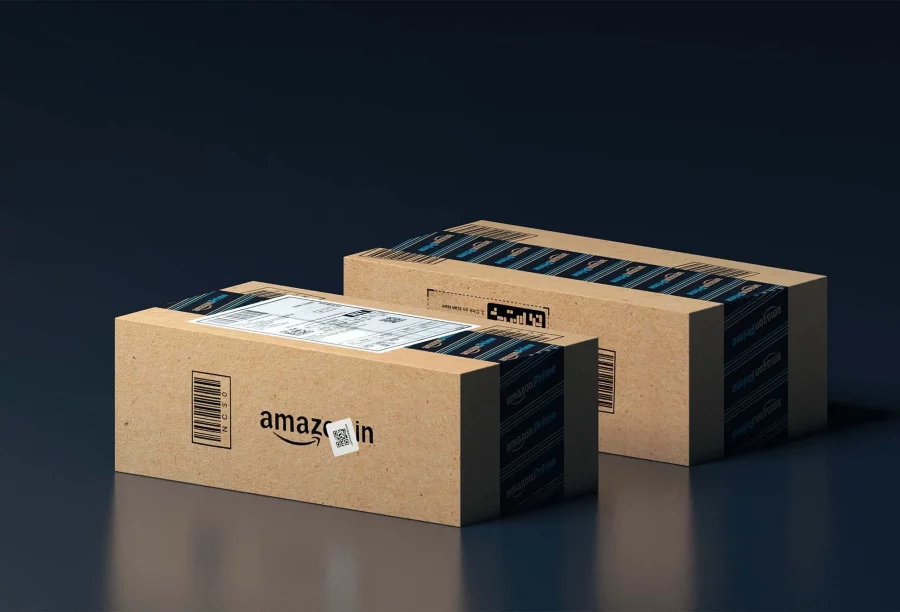
Shopify and Amazon are two of the most well-known names in the global e-commerce industry. Shopify is a specialized e-commerce platform that allows you to build and customize your own online store, while Amazon is an online marketplace where you can sell your products alongside millions of other sellers.
For first-time eCommerce store owners planning to enter an already crowded market with over 24 million potential competitors, which platform you select for maximum exposure matters.
Let’s dive deeper into the features and benefits of each platform to help you decide which is the best fit for your e-commerce needs.
Related Links
What Is Shopify?
Shopify is a cloud-based eCommerce platform enabling online retailers to build and manage standalone digital stores quickly. With millions of businesses powered by Shopify, including big names like Staples and Heinz, the platform offers scalability for businesses of all sizes.

Shopify provides users with 80+ professionally designed templates to customize and create a unique brand identity. The platform also offers built-in payment processing through Shopify Payments, powered by Stripe, making it seamless to accept online payments.
In addition, Shopify offers a wide range of store and customer management features, including social media integration, discount and gift card options, secure customer information storage, and integration with fulfillment centers, including Amazon.
What Is Amazon?
If you want to tap into a massive customer base, selling on Amazon is a strategic move. With billions of shoppers visiting the platform monthly, Amazon offers unparalleled access to a global audience.

Setting up your seller profile and listing your products on Amazon is relatively straightforward, and the platform provides automatic access to millions of potential customers. One of the significant advantages of selling on Amazon is the option to use Fulfillment by Amazon (FBA).
With FBA, Amazon stores your inventory, handles packaging, and takes care of shipping when orders come through. This streamlined fulfillment process can save you time and effort, allowing you to focus on other aspects of your business.
Shopify vs. Amazon – Which eCommerce Platform Should You Pick in 2024?
Let’s delve into a detailed comparison of the two platforms. We’ll evaluate critical factors such as ease of use, design flexibility, e-commerce tools and features, payment options, attracting customers, help and support, and pricing.
Ease of use
Both Shopify and Amazon offer user-friendly interfaces that make setting up and managing your online store relatively easy. However, there are some differences in the onboarding process and overall user experience.
- Shopify provides a straightforward setup process, guiding you through the essential steps to get your store up and running. The platform’s intuitive dashboard allows you to add products seamlessly, configure payment options, and manage your inventory. Shopify also offers extensive help and support resources, including 24/7 phone and live chat assistance.
- Amazon’s setup process is relatively simple, especially for individual sellers. However, the platform may feel more complex when managing orders and understanding the various seller tools and features. Amazon’s support options are also less accessible than Shopify, with phone support being available by request only.
Design flexibility
When it comes to design flexibility, Shopify outshines Amazon.
- With Shopify, you can access a wide range of professional themes that can be customized to match your brand’s style and create a unique online store. The platform’s themes are designed specifically for selling, ensuring a visually appealing and optimized shopping experience for your customers.
- Amazon, on the other hand, has limitations in terms of design customization. While you can upload your images and descriptions, the overall layout and design of your store pages are controlled by Amazon, making it challenging to differentiate your brand.
E-commerce tools and features
Both Shopify and Amazon offer a range of e-commerce tools and features to help you manage and grow your online store.
- Shopify’s strength lies in its extensive sales features, including abandoned cart recovery, AI-powered product description generation, automatic tax calculation, and multichannel selling. The platform also supports compliance with various financial regulations, such as providing a Shopify 1099 form for tax reporting, which is essential for merchants.
- Additionally, Shopify has an app store with thousands of apps like image optimizer, live chat, ugc videos, and more. Allowing you to enhance your store’s functionality and tailor it to your specific needs.
- Amazon provides a wide range of features tailored to different sellers’ needs. However, customization options are limited, and you are restricted to the same tools as other sellers on the platform. This can make it harder to stand out and build a unique selling proposition.
Payment options
- Shopify offers more flexibility compared to Amazon. Shopify Payments, the platform’s payment gateway, supports over 100 payment options and allows you to accept credit and debit cards without any transaction fees. This transparent pricing model helps you budget effectively and avoid unexpected costs.
- Amazon’s main payment gateway is Amazon Pay, which accepts credit and debit cards. However, it does not support popular options like PayPal. The fees associated with selling on Amazon can be more variable and less transparent, depending on product category, referral, and fulfillment fees.
Attracting customers and marketing
- Shopify provides the tools and resources to market your online store effectively. It offers features such as discount codes, email campaigns, social media integration, and SEO optimization. But your primary responsibility is attracting customers and driving traffic to your store.
- Amazon brings millions of visitors to its marketplace, giving you access to a ready-made customer base. The competition is fierce, and you’ll need to optimize your product listings and implement Amazon SEO strategies to stand out. Amazon’s reach provides exposure, but you must still market your products and actively differentiate yourself from other sellers through authentic marketing.
Help and support
- Shopify is known for its excellent customer support and extensive help resources. The platform offers 24/7 phone and live chat support, ensuring assistance is available whenever needed. Shopify’s Help Center provides a comprehensive collection of articles, video tutorials, and a community forum where you can find answers to common questions.
- Amazon also offers support options, including phone support and a help forum. However, the support system is generally less accessible and comprehensive compared to Shopify’s. The documentation and resources provided by Amazon may require more effort to navigate and find the information you need.
Pricing and value for money
- Shopify offers three pricing plans to accommodate businesses of all sizes: Basic Shopify ($29 per month), Shopify ($79 per month), and Advanced Shopify ($299 per month). Each plan offers different levels of features and scalability to meet your specific needs. Shopify’s transparent pricing allows you to budget effectively and avoid surprises.
- Amazon, on the other hand, offers different selling plans depending on your business size and needs. The Professional Selling plan costs $39.99 monthly, while the Individual Selling plan charges $0.99 per item sold. However, additional fees, such as referral and fulfillment, can vary depending on your product category and other factors.
| Feature | Shopify | Amazon |
|---|---|---|
| Ease of use | Straightforward setup | Complex order management |
| Design flexibility | Wide range of customizable themes | Limited design customization |
| Ecommerce tools | Extensive sales features and app store | Limited customization options |
| Payment options | 100+ payment options, transparent pricing | Limited payment options, variable fees |
| Attracting customers | Marketing tools and resources | Fierce competition, need for optimization |
| Help and support | 24/7 phone and live chat support, comprehensive help center | Less accessible support system |
| Pricing | Transparent pricing, plans for all sizes | Varying plans and additional fees |
The Verdict: Integrating Shopify And Amazon For Best Results
After analyzing the pros and cons of Shopify vs. Amazon, it becomes clear that both platforms can benefit your e-commerce business. By leveraging the strengths of each platform, you can maximize your reach, increase brand visibility, and drive traffic to your Shopify store.
Using Amazon as a supplementary revenue stream allows you to tap into its massive customer base and benefit from its efficient fulfillment services. Meanwhile, Shopify provides complete ownership over your online store, enabling you to build a unique brand identity and customer experience.
You can integrate the two platforms if you want to leverage the benefits of both Shopify vs. Amazon. This allows you to build your online store using Shopify while selling your products on Amazon’s marketplace.
By integrating Shopify and Amazon, you can maximize your exposure, reach a broader customer base, and benefit from the convenience of Amazon’s platform. You must create an Amazon Seller account and add the Amazon Sales Channel to your Shopify store to integrate the two platforms.
Integrating Shopify and Amazon allows you to synchronize your inventory, link products, and manage orders seamlessly. It provides a powerful combination of Shopify’s customization and control with Amazon’s massive reach and customer base.
How Do You Choose Shopify Vs. Amazon?
Are you confused about how to select your best eCommerce platform? Here are some of the tips to get you started:
- Spend time researching and understanding the specific needs of your business before deciding on the most suitable platform(s) for your e-commerce store.
- Consider your long-term goals, budget, target audience, and the level of control and customization you desire when deciding.
- Explore the vast range of apps and integrations available on Shopify’s App Store to enhance the functionality and capabilities of your online store.
- Continuously analyze and optimize your eCommerce strategy to leverage the strengths of both Shopify and Amazon and stay ahead of the competition.
The global eCommerce landscape constantly evolves, and what works for one business may not work for another. So, stay flexible, adapt to changes, and continue refining your approach to succeed in eCommerce.
Conclusion
Choosing the right e-commerce platform for your business depends on your specific needs and goals. Shopify and Amazon offer distinct advantages and cater to different types of sellers.
Shopify provides control, customization, and robust e-commerce tools and features. It allows you to build and customize your online store, create a unique brand identity, and access various payment options. Shopify’s pricing plans are transparent, and the platform offers excellent help and support resources.
On the other hand, Amazon offers a massive marketplace with a built-in customer base and global reach. It provides convenience and exposure, allowing you to tap into Amazon’s vast audience without the need to build and market your store. Amazon also offers additional services like fulfillment and storage, simplifying the logistics of running your business.
When comparing Shopify vs. Amazon, consider factors such as design flexibility, e-commerce tools, payment options, attracting customers, help and support, and pricing to make an informed decision.
Remember, there’s also the option to integrate Shopify and Amazon, combining the strengths of both platforms to maximize your sales and reach. Whichever platform you choose, with the right strategies and dedication, you can build a successful e-commerce business and thrive in the online marketplace.
Contact Matchbox Design Group Today!
If your website could use a refresh or you’re looking to drive more traffic to your site, fill out the form below and we’ll contact you to learn more about your digital needs.
Shopify Vs. Amazon FAQ:
Q: Why do people buy from Shopify instead of Amazon?
A: People choose Shopify over Amazon for various reasons. Shopify offers more flexibility and control over the branding and design of an online store. Additionally, some sellers prefer Shopify’s subscription-based model without transaction fees, allowing for better profit margins compared to Amazon’s per-sale fees.
Q: Is it better to dropship on Amazon or Shopify?
A: The choice between dropshipping on Amazon or Shopify depends on individual preferences and business goals. Amazon provides a larger customer base, but competition is fierce. Shopify allows more control over the business and branding, making it suitable for those who want a unique online store.
Q: Do people really make money dropshipping on Amazon?
A: Yes, some people do make money dropshipping on Amazon. However, success depends on various factors, including product selection, marketing strategies, and effective management of inventory and customer service. It’s a competitive market, so success in dropshipping requires careful planning and execution.
Q: Who is Shopify best suited for?
A: Shopify is best suited for individuals and businesses looking to set up and manage their online store with ease. It caters to a wide range of entrepreneurs, from beginners to experienced sellers, providing a user-friendly platform with various customizable features.
Q: Can I sell items on Shopify from Amazon?
A: While you can integrate Amazon with Shopify, selling items directly from Amazon on a Shopify store may violate Amazon’s policies. It’s essential to check and comply with both platforms’ terms of service to avoid any potential issues.
Q: Can I transfer my Shopify store to Amazon?
A: There isn’t a direct transfer option from Shopify to Amazon. Each platform operates independently, and transitioning between them involves setting up a new account on the desired platform. Products, listings, and other details would need to be recreated on the new platform.
Q: Is it easy to sell on Amazon?
A: Selling on Amazon can be both easy and challenging. The platform provides a straightforward process for listing products, and the large customer base is advantageous. However, competition is intense, and sellers need to navigate Amazon’s policies, optimize product listings, and employ effective marketing strategies to succeed.

